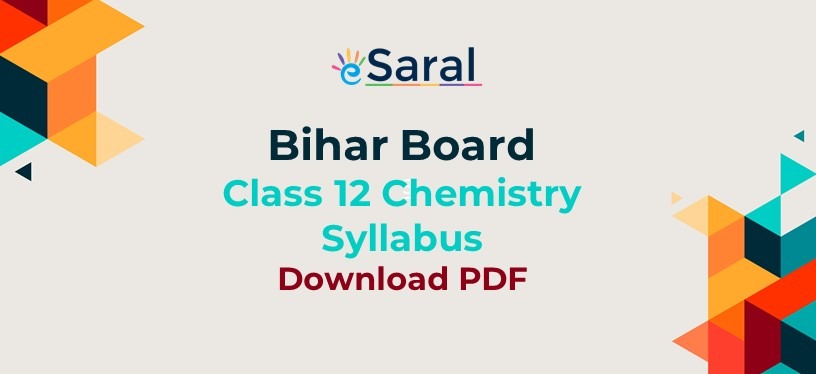
Students who are preparing for Bihar Board Class 12 Exam will get here Bihar Board 12th Chemistry Syllabus with the unit-wise Marks distribution. This will help the aspirants to know about the chapters having more weightage. Also get the PDF of Detailed Syllabus in this Article.
Here is the detailed chapter wise Bihar Board 12th Chemistry syllabus below:
Unit 1: Solid State
Chemistry Syllabus Class 12: Unit wise Marks Distribution
| Unit | Marks |
| Unit 1: Solid State | 04 |
| Unit 2: Solution | 05 |
| Unit 3: Electrochemistry | 05 |
| Unit 4: Chemical Kinetics | 05 |
| Unit 5: Surface Chemistry | 03 |
| Unit 6: General Principle & Processes of Isolation of Elements | 03 |
| Unit 7: p-block Elements | 08 |
| Unit 8: d and f-block Elements | 05 |
| Unit 9: Co-ordination compounds | 03 |
| Unit 10: Haloalkane & Haloarenes | 04 |
| Unit 11: Alcohols, Phenols& Ethers | 04 |
| Unit 12: Aldehyde, Ketone and Carboxylic Acid | 06 |
| Unit 13: Organic compounds containing Nitrogen | 04 |
| Unit 14: Biomolecules | 04 |
| Unit 15: Polymers | 03 |
| Unit 16: Chemistry in everyday life | 03 |
- Classification based on different binding forces
- Crystalline and Amorphous Solid
- Unit cell: in two dimensional and three dimensional lattices, density of unit cell, packing in solids, voids, number of atoms per unit cell, point defects.
- Band theory: Metals, Conductors and Semiconductors and Insulators
- n and p-type semiconductors.
- Types of solutions
- Expressing Concentration of solutions
- Osmosis and Osmotic Pressure
- Colligative Properties & Determination of Molar mass
- Abnormal molecular mass
- Vapour Pressure of Liquid solutions
- Depression of Freezing point.
- Redox Reactions
- Electrolytic Cells and Electrolysis: Electrolytic Solutions
- Galvanic Cells, Dry Cells and electrolytic Cells: EMF of a cell.
- Nernst Equation and its applications.
- Kohlraush’s Law
- Corrosion
- Fuel Cells
- Rate of Reaction: Integrated Rate of a reactions, factors affecting the rate of reaction, Temperature dependence.
- Order and molecularity of a reaction, rate law, specific rate constant, integrated rate equations and half life.
- Concept of collision theory.
- Activation energy
- Arrhenius equation.
- Adsorption: factors affecting adsorption of gases on solids
- Catalysis, homogenous and heterogeneous activity and selectivity; enzyme catalysis colloidal state distinction between true solutions,
- Colloids: Preparation of colloids and suspensions
- Properties of Colloids: Tyndall effect, Brownian movement, electrophoresis, coagulation. Emulsion: types of emulsions.
- Principles and Methods of extraction
- Oxidation and Reduction
- Electrolytic method and refining
- Occurrence of extraction of aluminium, copper, zinc and iron.
- Introduction, Configuration, Oxidation State, Occurrence, Physical & Chemical Properties.
- Nitrogen: Preparation properties, uses, compounds, properties of ammonia and nitric acid, oxides of nitrogen.
- Phosphorus – allotropic forms, compounds of phosphorus: preparation and properties of phosphine, halides PCl3 , PCl5 and oxoacids.
- Introduction, Configuration, Oxidation State, Occurrence, Physical & Chemical Properties.
- Dioxygen: Preparation properties and uses
- Oxides: Classification of Oxides, Ozone.
- Sulphur: Sulphur allotropic form, Compounds of sulphur, uses of Sulphur-di-oxide, Sulphuric acid, oxoacids of sulphur.
- Introduction, Configuration, Oxidation State, Occurrence, Physical & Chemical Properties.
- Halogen Compounds, uses of Chlorine and Hydrochloric Acid, interhalogen compounds, oxoacids of halogens.
- Introduction, Configuration, Oxidation State, Occurrence, Physical & Chemical Properties.
- Introduction, Configuration, Oxidation State, Occurrence, Physical & Chemical Properties.
- Transition Metals: Characteristics and Occurrence
- Potassium Dichromate & Potassium Permanganate: Preparation and Properties
- Lanthanoids – Electronic configuration, oxidation states, and lanthanoid contraction.
- Actinoids – Electronic configuration, oxidation states.
- IUPAC nomenclature of mononuclear coordination compounds.
- Bonding in Metal carbonyl’s
- Introduction and Werner’s theory of Coordination Compounds.
- Valence Bond theory and Crystal field Theory: structure and stereo isomerism, importance.
- Haloalkanes: Classification, Applications, Nomenclature, nature of C-X bond.
- Haloarenes: Nature of C -X bond, substitution reactions
- Uses and environmental effects of – dichloromethane, trichloromethane, tetrachloromethane, iodoform freons, DDT.
- Alcohols: Nomenclature, preparation methods, physical and chemical properties, identification of alcohols (Primary, Secondary, and Tertiary), mechanism of dehydration, Uses.
- Phenols: Nomenclature, methods of preparation, Properties, acidic nature of phenol, electrophilic substitution reactions, uses of phenols.
- Ethers: Nomenclature, Preparation Methods, Properties and Uses.
- Aldehydes and Ketones: Nomenclature, Preparation Methods, Properties, Nucleophilic addition reaction.
- Carboxylic Acids: Nomenclature, acidic nature, methods of preparation, physical and chemical properties; uses.
- Amines: Structure, Classification, Nomenclature, Preparation Method, Properties, Uses, Identification of Amines (Primary, Secondary & Tertiary).
- Cyanides and Isocyanides: Structure, Classification, Nomenclature, Preparation Method, Properties and Uses
- Diazonium salts: Structure, Classification, Nomenclature, Preparation Method, Properties, and importance in synthetic organic chemistry.
- Carbohydrates: Classification and Uses.
- Proteins: Structures, Elementary idea of α – amino acids, peptide bond, polypeptides, proteins. Denaturation of proteins and enzymes.
- Vitamins: Classification and functions.
- Nucleic Acids: DNA and RNA structures.
- Classification, Polymerization Method, Copolymerization
- Natural and Synthetic Polymers.
- Biodegradable and non-biodegradable polymers.
- Chemicals in Foods.
- Drugs and their Classification
- Chemicals in medicines: antiseptics, disinfectants, antifertility drugs, antibiotics, antacids, antihistamines etc.
- Chemicals in food: Preservatives, artificial sweetening agents.
- Cleansing agents: Soaps and detergents, cleansing action.
Download BIHAR BOARD 12 CHEMISTRY DETAILED SYLLABUS PDF
This information would be useful for those who are looking for Chemistry Class 12th Syllabus of Bihar Board. Get to know the detailed syllabus of Class 12th for all Subjects and prepare accordingly for upcoming Exams. Download eSaral App and get access to interactive learning and Video lectures related to Boards, JEE & NEET Preparation. CLICK HERE & Get Bihar Board Syllabus 12th Science 2019 in PDF form.Comments
nitish kumar harni 7781837915
Oct. 30, 2020, 5:15 p.m.
nitishkumar harni jamui khaira harni chemistry notes pdf mai sir
